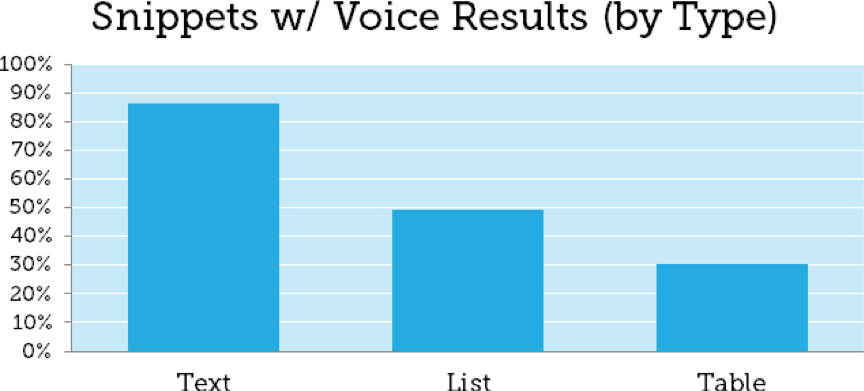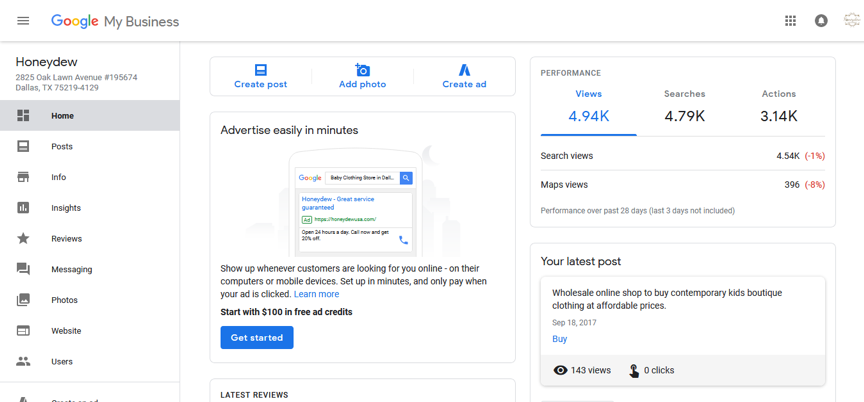

Updated January 3, 2025
People are using voice searches more than ever before. To rank in voice search results, websites must be properly optimized to anticipate how people ask questions while searching for information.
Voice search was once a playful functionality for mobile phone users – but today, it has become an important element of SEO.
Voice search may represent a paradigm shift in how companies plan their SEO strategies. Websites that are optimized for voice search will recognize that people don’t type the way they speak.
Looking for a SEO agency?
Compare our list of top SEO companies near you
As search engines evaluate the impact of voice search, businesses must understand how it will impact their SEO practices.
You can use this article to learn how to optimize your website for voice search.
Voice search allows users to ask their devices questions out loud, rather than typing queries into a search engine. You can now find voice search on smartphones, tablets, and voice assistants such as Amazon Alexa.
You can use your voice to search for information online, including the location of a business, answers to questions you’re curious about, or the date of an upcoming event. For example, if you say, “Italian restaurants near me,” a voice search-enabled device can find Italian restaurants close by.
Voice search is especially effective when users are unable to look at their phones. For example, if you are driving, it’s safer to keep your eyes on the road while asking your phone for directions. Similarly, if you’re cooking and don’t want your phone to get dirty, you can use voice search to request the next step in a recipe.
Voice search is a useful innovation that makes search easier.
Voice search is becoming more widely accepted, and more gadgets and appliances are equipped with voice search technology.
According to comScore, 40% of adults now use voice search once per day, resulting in over one billion voice searches every month.
One reason voice search is becoming more popular is that voice search tools have become more accurate.
Google’s word recognition rate has improved since it launched initially. As of 2017, Google's voice recognition boasted 95% accuracy. This growth demonstrates that Google recognizes the popularity of the tool and will continue to improve user experience.
However, research by Brightedge revealed that most marketers have not yet incorporated voice search in their marketing strategies.
As voice search becomes more popular with consumers, marketers will need to incorporate it into their SEO strategies.
Every tech giant now offers their own voice search assistant: Google has Google Home, Amazon has Alexa, and Apple has Siri. Each has earned worldwide recognition, and users are increasing rapidly.
According to a study by AYTM, Siri appears to be the most popular voice assistant, with 45% of people who have used a voice assistant selecting it. One third of users (33%) say they’ve used Google Now, and smaller percentages have used Microsoft’s Cortana (27%) and Amazon Eco or Alexa (10%).
Even lesser known voice search assistants have attracted users. Microsoft’s Cortana has 148 million users worldwide.
In addition to attracting users, voice search assistants engage users effectively. HubSpot recently found that approximately 19% of consumers use Siri every day.
High levels of usage show that marketers can’t ignore the importance of voice search. Marketers must design an SEO strategy that covers voice search.
As more users adopt voice search, patterns of behavior are emerging. Key factors supporting voice search include:
Generally, people who use voice search ask questions as if they are in conversation.
This can lead to humorous situations. For example, a video of an 85-year-old grandmother went viral when she was spooked by her voice assistant’s seemingly magical answers to her questions.
Studies show that 70% of Google assistant searches are conversational.
Given this finding, you should write content that is more conversational, mirroring the way we talk and communicate in our daily lives.
For example, if a person wants to find out the distance between New York and New Jersey, she might type “distance between New York and New Jersey. By comparison, when using voice search, she might ask, “How far is it from New York to New Jersey?”
Businesses should optimize their content to respond to both written and spoken versions of users’ common questions in order to appear in voice search results.
To achieve a high ranking in search results, it is now essential to have a mobile-optimized website with a seamless user interface. Websites that are responsive on mobile devices also have a better chance of ranking for voice searches.
According to Google, one in five mobile queries (20%) are voice searches.
If you don’t have a mobile-friendly website already, it should be your top priority. A web developer can help improve the responsiveness of your website so that it displays clearly on all mobile devices, including smartphones and tablets.
When ranking pages, Google takes load time into account. Load time is the time a page takes to download and display the entire content of a webpage.
Two in five users (40%) will switch to other results if your website did not load in 3 seconds.
People who search on mobile devices are typically on the go. They will abandon your website instantly if it takes time too long to load.
Reducing load time can help ensure that your website ranks well for all searches, including voice searches.
To optimize your website for voice search, you need to determine how search engines react to voice searches and how they depict search results.
When you query with voice search, search engines react in one of two ways: asking a question or searching for specific information.
If you ask a question, your device will offer an answer in the featured snippet.

In this example, the featured snippet displays the answer to the implied question, “What is the equivalent of $1 USD in pounds?”
If you search for specific information, your device will offer relevant website links.

In this example, a search for blog posts on Clutch will display links to blog posts or blog-related content.
Once you determine the type of query your content answers, you can determine how to structure your website content to rank for voice search results.
One way to improve your web traffic from voice searches is to come up in the featured snippet position.
A study by Moz found that 87% of voice search results are pulled directly from featured snippets.
The Moz study found that featured snippets are most likely to be pulled directly from website text when voice search is used.

Lists and tables are less likely to rank for voice searches.
Once you finalize your keywords, write a search description of around 160 characters Include your keyword once in the search description. This description, combined with optimized website content, will increase your chances of ranking in voice search results.
If you are not using Schema markup, you should start now. Schema markup helps search engine crawlers understand your content by putting it on your website to help search engines return even more useful results for different users.
For example, if you are organizing an event, you can include schema markup to alert search engines that your web content contains a schedule of events.
If you aren’t sure which schema markup to select, Schema.org is a free resource that can help you identify the right markup.
When you developed your website content, you probably created a list of keywords that are relevant to your business.
When attempting to rank content for voice searches, you should expand your list of keywords to include long-tail keywords, which are defined as the keywords that contain at least three words
To rank for long-tail searches, start by identifying the keywords that are typically used for voice searches. When brainstorming long-tail keywords, you can use tools such as Answer the Public for inspiration.
Once you determine which keywords are most likely to be used conversationally, you can develop natural, conversational website content tailored to your long-tail keywords.
For example, if you are in refrigerator repair business, you can use keywords such as “emergency refrigerator repair services in New York” or “refrigerator service near me.”
Long-tail keywords help pages rank for voice search because they are similar to conversational statements.
Because voice search users often phrase their queries as questions, pages featuring frequently asked questions (FAQ) are more likely to rank for keywords.
However, you need to make sure that your FAQ page is genuinely helpful to users. To start, analyze and evaluate all the queries that you have received over the past one to three months. From those queries, you can develop a list of questions that are asked frequently.
Like long-tail keywords, FAQ pages tend to rank for voice searches because they are naturally conversational.
Google My Business is a free listing Google offers to local businesses. Whether you have a local brick and mortar store in your area or a small online business, with the Google My Business page, you can improve your brand visibility and awareness.
When people use voice search to find a business, Google prioritizes shops and service providers that are nearby. This is especially true when a voice search user asks for results and concludes their question with the phrase “near me.”
Businesses that don’t have a location-based Google My Business profile lose their chance to appear in the search results.

If you don’t have a Google My Business profile, you can easily create one. You’ll be asked to enter your company’s name, hours, address, contact details, and website URL. This information will then be displayed in search results, including Google Maps.
If you already have a profile, you should periodically update it with the latest information about your company, such as holiday hours.
Once you have updated your Google My Business profile, make sure that the information matches any listings on other websites, such as Yelp or TripAdvisor, to avoid confusing search engines and users.
When created correctly, Google My Business can increase your business’s chances of ranking for “near me” searches.
Voice search will only become more powerful as voice assistants attract more users. To continue ranking for keywords in the future, companies must prioritize optimizing their websites for voice search now.
Fortunately, you can optimize your website for voice search by making simple changes. Long-tail keywords, conversational language, and a strong FAQ page are proven ways to increase your changes of ranking in voice search results.
Companies that develop an SEO strategy for voice search will gain a competitive advantage over other businesses.
 Ted Mikulski is a senior SEO expert at ClickMatix, a company that helps clients improve their digital presence. He has expertise in SEO, PPC, and SMO, plus over 10 years of experience in digital marketing. He has taken care of more than 1,000 clients and hundreds of online web projects. He is now focused on researching the changing trends of internet marketing.
Ted Mikulski is a senior SEO expert at ClickMatix, a company that helps clients improve their digital presence. He has expertise in SEO, PPC, and SMO, plus over 10 years of experience in digital marketing. He has taken care of more than 1,000 clients and hundreds of online web projects. He is now focused on researching the changing trends of internet marketing.


